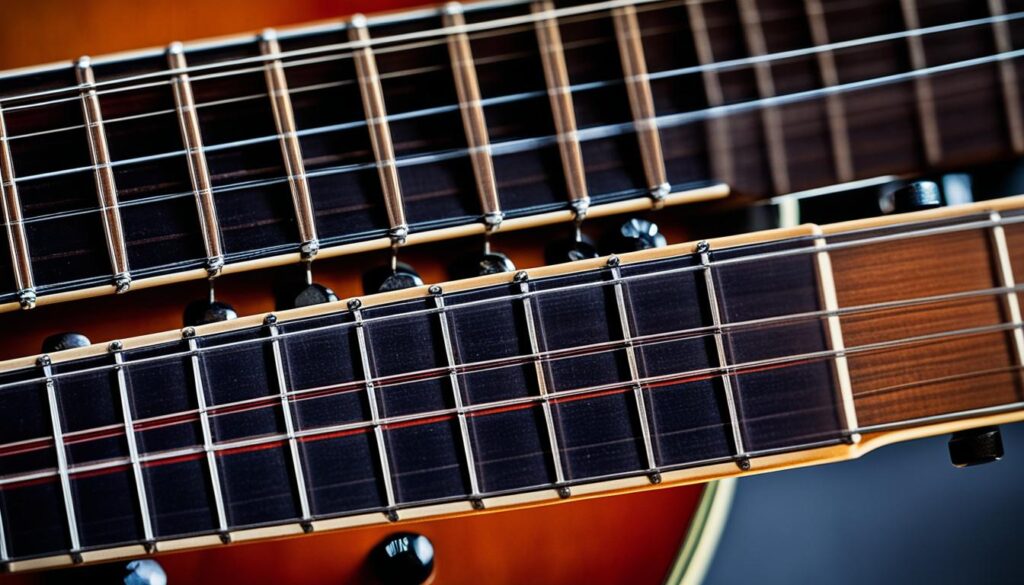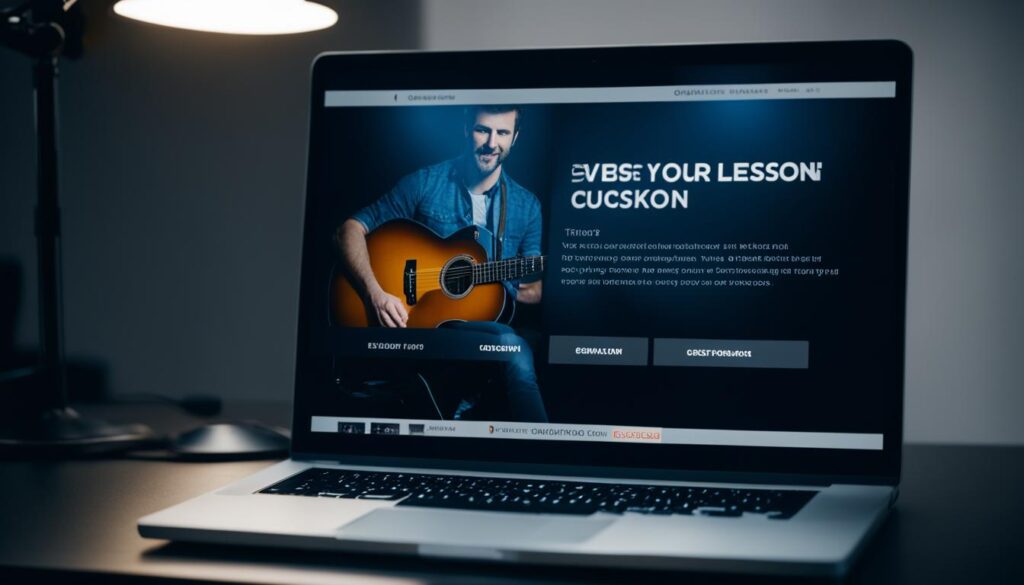Strumming From Scratch: A Beginner’s Guide To Playing The Guitar
Welcome to our comprehensive beginner’s guide to playing the guitar! Whether you’ve never picked up a guitar before or have some prior musical experience, this guide is designed to walk you through the basics and help you embark on your musical journey. Playing the guitar is a rewarding and enjoyable skill that can be learned by anyone with dedication and practice.
Throughout this guide, we will cover everything you need to know to get started, from choosing the right guitar to essential techniques and playing your first song. By the end, you’ll have a strong foundation and the tools necessary to continue expanding your skills.
If you’re ready to unleash your inner musician and learn to play the guitar, read on!
Key Takeaways:
- Playing the guitar is an attainable skill for beginners.
- Choosing the right guitar is crucial for your playing experience.
- Mastering chords and techniques will enhance your skills.
- Playing your first song is an exciting milestone in your guitar journey.
- Online resources offer convenient and accessible guitar lessons for beginners.
Choosing the Right Guitar
Before embarking on your guitar playing journey, it’s crucial to select the right instrument that suits your preferences and playing style. Whether you’re drawn to the soulful sounds of an acoustic guitar or the electrifying riffs of an electric guitar, we’ll guide you through the process of choosing the best guitar for you.
When it comes to deciding between an acoustic or electric guitar, there are a few factors to consider:
- Sound: Acoustic guitars produce a warm and natural sound, making them perfect for intimate settings or unplugged performances. On the other hand, electric guitars offer a wider range of sounds and can be amplified for larger venues and genres such as rock or blues.
- Playability: Acoustic guitars generally have thicker strings and higher action, which may require more finger strength and precision. Electric guitars typically have thinner strings and lower action, making them easier to play, especially for beginners.
- Genre: Think about the style of music you want to play. Acoustic guitars are often associated with folk, country, and singer-songwriter genres, while electric guitars are commonly used in rock, blues, and metal.
- Portability: Acoustic guitars are self-contained instruments, allowing you to play anywhere without the need for additional equipment. Electric guitars require an amplifier, cables, and other accessories for optimal sound.
Now that you have an idea of the main differences between acoustic and electric guitars, it’s time to make a decision.
If you’re still unsure, consider visiting a local music store to try out different models and get a feel for how they sound and play. Remember, the best guitar for you is ultimately the one that feels comfortable in your hands and inspires you to keep playing.
Once you have chosen your guitar, it’s time to delve into learning the basics of playing this incredible instrument. In Section 3, we will cover essential information on how to hold the guitar, understand its different parts, and tune it to ensure you start off on the right note.
Learning the Basics
Building a strong foundation is essential when learning to play the guitar. In this section, we will cover the basics to help you learn guitar fundamentals and get started on your musical journey.
Hold the Guitar
Before you can learn to play the guitar, it’s important to know how to hold the instrument correctly. Start by sitting up straight with the guitar resting on your right leg (if you’re right-handed). Place your left hand on the neck of the guitar, while your right hand hovers above the soundhole. Holding the guitar in this position will provide stability and enable you to play more comfortably.
Guitar Strings
The guitar has six strings, numbered from the thickest to the thinnest. From low to high, they are referred to as E, A, D, G, B, and E again. Take a moment to familiarize yourself with the names and order of the strings, as they’ll be essential for playing chords and melodies.
| String | Note |
|---|---|
| E | Lowest pitch, thickest string |
| A | |
| D | |
| G | |
| B | |
| E | Highest pitch, thinnest string |
Tuning a Guitar
To produce accurate and pleasing sounds on the guitar, it’s crucial to tune your instrument correctly. There are several methods for tuning a guitar, including using an electronic tuner or tuning by ear using a reference pitch. Whichever method you choose, make sure each string is tuned to the correct pitch. Keeping your guitar in tune will ensure that the chords and melodies you play sound harmonious.
Understanding the Different Parts of the Guitar
Before diving into playing, getting familiar with the different parts of the guitar is essential. This knowledge will help you understand how the instrument works and how to make adjustments if needed. Here are the main parts of an acoustic guitar:
- Headstock: Located at the top of the guitar neck, the headstock holds the tuning pegs.
- Tuning Pegs: These small gears allow you to tighten or loosen the guitar strings for tuning.
- Neck: The long, thin part of the guitar where you place your left hand to press on the strings. It’s divided into frets.
- Fingerboard: Also known as the fretboard, this is the front surface of the neck where you press the strings to produce different notes.
- Body: The large, hollow section of the guitar that amplifies the sound produced by the strings. It typically has a soundhole, bridge, and pickguard.
- Bridge: The bridge holds the guitar strings in place and transfers their vibrations to the body to create sound.
- Pickguard: This protective plate is commonly found on the body of the guitar, underneath the soundhole. It prevents scratches from constant strumming.
By understanding the different parts of the guitar, you’ll develop a deeper appreciation for the instrument and be better equipped to take care of it.
In the next section, we will dive into mastering guitar chords, an essential skill for every beginner guitarist.
Mastering Guitar Chords
Chords are the building blocks of playing the guitar. Whether you’re a beginner or have some experience, mastering different chord shapes is crucial to advancing your playing skills. In this section, we will guide you through the process of learning guitar chords, exploring common chord progressions, and familiarizing yourself with open and minor chords.
Understanding Guitar Chords
Before delving into chord progressions and shapes, it’s important to understand what guitar chords are. A chord is a combination of two or more notes played together, producing a harmonious sound. In the context of the guitar, chords are formed by pressing down multiple strings at specific fret positions to create different musical tones.
Common Chord Progressions
One of the most exciting aspects of learning guitar chords is discovering common chord progressions that are widely used in various music genres. These progressions provide a framework for composing and playing songs. By familiarizing yourself with popular progressions, you’ll be able to play a wide range of songs and develop your musical creativity.
Here are a few examples of common chord progressions:
- I-IV-V: This progression is often used in blues and rock music. It involves playing the I, IV, and V chords in a given key. For example, in the key of G major, the I, IV, and V chords are G, C, and D, respectively.
- vi-IV-I-V: This progression is commonly found in pop and rock music. It includes the vi, IV, I, and V chords in a given key. For instance, in the key of C major, the vi, IV, I, and V chords are Am, F, C, and G, respectively.
- I-V-vi-IV: This progression is known as the “four-chord progression” and can be heard in countless popular songs. It features the I, V, vi, and IV chords in a given key. For example, in the key of G major, the I, V, vi, and IV chords are G, D, Em, and C, respectively.
Open and Minor Chords
Open chords are fundamental to playing the guitar and are usually the first chords beginners learn. They are called “open” because they involve playing at least one open string. Open chords are versatile and are commonly used in various genres, allowing you to play a wide range of songs.
Minor chords, on the other hand, add a touch of melancholy or tension to a progression. They are an essential component of music theory and can evoke different emotions. By incorporating minor chords into your playing, you’ll be able to create more intricate and nuanced sounds.
Now that we’ve explored the basics of guitar chords, chord progressions, and open and minor chords, it’s time to put your knowledge into practice. Practice playing different chord shapes, experiment with various progressions, and continue to expand your chord vocabulary. Remember that consistency and regular practice are key to mastering guitar chords and improving your overall playing abilities.

Essential Guitar Techniques
Learning to play the guitar involves more than just knowing a few chords. To truly become a proficient guitarist, it’s important to learn and master various techniques. In this section, we will introduce you to some essential guitar techniques for beginners, provide finger exercises to strengthen your fingers, teach you strumming techniques, and offer valuable tips to improve your guitar playing.
1. Finger Exercises
Before diving into complex melodies and solos, it’s crucial to develop strength, dexterity, and coordination in your fingers. Finger exercises help train your fingers to move smoothly across the fretboard and build muscle memory. Try practicing exercises like finger rolls, spider crawls, and chromatic exercises to enhance your finger agility and control.
2. Strumming Techniques
Strumming is an essential skill for every guitarist. It’s the rhythmic pattern created by the guitar pick or your fingers hitting the strings. Mastering strumming techniques allows you to create different rhythms and dynamics in your playing. Experiment with upstrokes and downstrokes, palm muting, and ghost notes to add depth and variety to your strumming patterns.
3. Guitar Playing Tips
Improving your guitar playing goes beyond practicing techniques. Here are some valuable tips to enhance your overall playing experience:
- Consistency is key: Set aside regular practice time to build muscle memory and improve your skills progressively.
- Start slow, then speed up: When learning a new piece or technique, start at a slower tempo and gradually increase your speed as you become more comfortable.
- Listen to different genres: Explore different styles of music to broaden your musical horizons and discover new techniques.
- Play with others: Joining jam sessions or playing with other musicians can help you develop your sense of timing and improvisational skills.
- Don’t be afraid to make mistakes: Learning the guitar is a journey, and making mistakes is part of the process. Embrace them as learning opportunities and keep pushing forward.
Remember, mastering the guitar takes time and dedication. By incorporating these essential techniques, finger exercises, strumming techniques, and guitar playing tips into your practice routine, you’ll be on your way to becoming a skilled guitarist.

| Technique | Benefits |
|---|---|
| Finger Exercises | Strengthen finger muscles, improve dexterity, enhance fretting accuracy |
| Strumming Techniques | Create rhythmic patterns, add dynamics to playing, develop a sense of groove |
| Guitar Playing Tips | Improve overall playing skills, enhance practice efficiency, expand musical knowledge |
Playing Your First Song
Playing your first song is an exciting milestone in your guitar journey. It’s the moment when you can apply what you’ve learned and create beautiful music. In this section, we will guide you through simple songs that are perfect for beginners, helping you build your beginners’ repertoire and gain confidence in your playing.
Before diving into learning songs, it’s important to understand some essential concepts that will make the process easier. One of them is reading guitar tabs. Guitar tabs are a universal language that allows you to read and play music on the guitar without having to learn sheet music notation. Tabs consist of numbers representing the frets on the guitar neck and indicate which string to play. By learning to read tabs, you can quickly learn and play your favorite songs.

Another critical skill is playing notes on the fretboard. Each fret on the guitar represents a different note, and by pressing down on a specific fret, you can create different tones and melodies. It may take some practice to develop the muscle memory needed to hit the right notes consistently, but with dedication and repetition, you’ll be able to play songs with ease.
Now, let’s dive into some easy guitar songs that will help you apply these concepts and start playing your first song:
1. “Knockin’ on Heaven’s Door” by Bob Dylan
This classic song features simple chord progressions and an iconic melody, making it an ideal choice for beginners. By learning the basic chords and strumming patterns, you’ll be able to play along to this timeless tune.
2. “Horse with No Name” by America
This folk-rock hit can be played using just two chords, making it extremely beginner-friendly. It’s a great song to practice your strumming and chord transitions.
3. “Wonderwall” by Oasis
“Wonderwall” is a favorite among beginner guitarists. With its catchy strumming pattern and simple chord progression, this song is an excellent addition to your repertoire.
Remember, practice is key when it comes to playing the guitar. Start slow, break down the songs into smaller sections, and gradually increase your speed. With time and dedication, you’ll be amazed at how quickly you can play your favorite songs.
So grab your guitar, have fun with these easy guitar songs, and enjoy the satisfaction of playing your first song!
Exploring Guitar Styles
When it comes to playing the guitar, there is a wide variety of styles and techniques to explore. Whether you prefer strumming along to your favorite songs or delving into intricate fingerstyle patterns, there is something for everyone. In this section, we will introduce you to different guitar styles such as rhythm guitar, fingerstyle, and lead guitar, as well as cover essential aspects like strumming patterns and guitar scales.
Rhythm Guitar
Rhythm guitar forms the foundation of most songs, providing the rhythmic backbone that keeps the music moving forward. As a rhythm guitarist, your role is to create a tight, consistent rhythm by strumming or picking chords. This style is often used in genres like rock, pop, and country music. Developing a good sense of timing and mastering strumming patterns is key to becoming an accomplished rhythm guitarist.
Fingerstyle
Fingerstyle guitar, also known as fingerpicking, is a technique that involves plucking the strings with your fingers instead of using a pick. This technique allows you to play melodies, chords, and bass lines simultaneously, creating a rich and multi-layered sound. Fingerstyle is commonly used in folk, classical, and acoustic guitar music. It requires precision, finger independence, and the ability to synchronize different finger movements.
Lead Guitar
Lead guitar is all about taking the spotlight and playing melodic lines that soar over the rest of the music. Lead guitarists often play solos, improvisations, and memorable guitar hooks that define a song. This style requires knowledge of scales, bending techniques, vibrato, and other expressive techniques that allow you to add your own personality to the music. Lead guitar is commonly found in rock, blues, jazz, and metal genres.
Strumming Patterns
Strumming patterns are an essential aspect of playing the guitar, especially for rhythm guitarists. They determine the groove and feel of a song, and different patterns can help create distinct musical styles. Experimenting with strumming patterns will enable you to add variation and dynamics to your playing. Practice different patterns in different genres to develop a versatile playing style.
Guitar Scales
Guitar scales are sets of musical notes arranged in a specific pattern. Learning scales is crucial for understanding music theory, improvisation, and creating melodies. By familiarizing yourself with scales, you can easily navigate the fretboard and play solos or lead lines with confidence. Some commonly used scales include the major scale, minor scale, pentatonic scale, and blues scale. Practice scales regularly to improve your dexterity and expand your musical vocabulary.
Now that you are familiar with different guitar styles, strumming patterns, and guitar scales, you can start exploring and incorporating these elements into your playing. Whether you want to strum along to your favorite songs, master complex fingerpicking patterns, or shred epic guitar solos, there is no limit to the possibilities. Remember to practice regularly, be patient with yourself, and enjoy the journey of becoming a skilled guitarist.

Online Resources for Guitar Lessons
In today’s digital age, beginner guitar players have a wealth of options when it comes to learning the instrument. Online guitar lessons have become increasingly popular, offering convenience and flexibility for individuals eager to embark on their musical journey. Whether you’re just starting out or looking to enhance your skills, online platforms provide a comprehensive learning experience designed to cater to your needs.
One standout resource for guitar lessons online is Guitar Tricks. With a vast library of lessons and tutorials, Guitar Tricks offers a step-by-step approach suitable for beginners. The platform covers everything from basic chord progressions to advanced techniques, empowering you to progress at your own pace.
If you prefer a more personalized experience, JamPlay is an excellent choice. With its extensive roster of experienced instructors, JamPlay offers weekly guitar lessons tailored to your skill level. Their interactive platform allows you to interact with instructors and fellow students, creating a supportive community that fosters growth and learning.
Why Choose Online Guitar Lessons?
Online guitar lessons provide the flexibility and convenience that traditional in-person lessons may lack. With the ability to access lessons from anywhere and at any time, you can fit learning the guitar into your schedule without feeling restricted by location or time constraints.
Additionally, online guitar lessons offer a variety of learning formats such as video tutorials, live lessons, and interactive exercises. This diverse range of resources ensures a well-rounded learning experience and caters to different learning styles.
Also Read:- Embark On Your Audio Journey: A Comprehensive Guide To Starting A Podcast
Weekly guitar lessons online also provide the opportunity for consistent practice and feedback. With regular lessons, you can establish a routine and receive guidance and support from experienced instructors as you progress on your guitar-playing journey.
Choosing the Right Online Guitar Lessons for You
When selecting online guitar lessons, consider your learning goals, preferences, and budget. Research different platforms, read reviews, and compare the features they offer to find the one that aligns with your needs.
Some important factors to consider include the variety and depth of lesson content, the quality of instruction, the level of interactivity, and the availability of additional resources such as tabs and sheet music.
Remember, as a beginner, it’s essential to choose lessons specifically designed for beginner guitar players. Look for platforms that provide a strong foundation in guitar fundamentals and gradually progress to more advanced techniques.

With the abundance of online resources available, it can be overwhelming to choose the right one. However, by taking the time to research and identify your specific needs and preferences, you can find online guitar lessons that will help you develop your skills and achieve your musical goals.
Conclusion
In conclusion, this beginner’s guide to playing the guitar has equipped you with the essential knowledge and skills to embark on an exciting musical journey. By following the step-by-step instructions provided and dedicating regular practice time, you will be well on your way to becoming a skilled guitarist.
Remember, learning any instrument requires patience, persistence, and perseverance. Rome wasn’t built in a day, and neither is musical proficiency. Embrace the learning process, enjoy the challenges, and celebrate the small victories along the way.
As you continue on your guitar-playing path, remember to explore different genres, experiment with new techniques, and challenge yourself to learn more complex pieces. The guitar offers limitless possibilities for creativity and self-expression, so don’t be afraid to push the boundaries and discover your unique musical voice.
Whether you aspire to join a band, perform on a stage, or simply strum away in the comfort of your own home, the guitar will be a lifelong companion that brings joy and fulfillment. So, seize the opportunity and start your musical adventure today!
FAQs
Q: What is the best way to start learning how to play guitar as a beginner?
A: The best way to start learning how to play guitar as a beginner is by taking beginner guitar lessons or using online resources specifically designed for newcomers.
Q: How can I learn basic guitar chords?
A: You can learn basic guitar chords by practicing regularly, following tutorials, and using chord charts to familiarize yourself with different chord shapes.
Q: What should I keep in mind when holding a guitar for the first time?
A: When holding a guitar for the first time, make sure to position the instrument comfortably on your lap, keep your wrist loose, and place your fingers on the fretboard as instructed.
Q: How can I play guitar chords and learn simultaneously?
A: You can play guitar chords and learn simultaneously by practicing chord transitions, following structured lessons, and incorporating chord changes into songs you are learning.
Q: What are some common mistakes to avoid when learning how to play guitar?
A: Some common mistakes to avoid when learning how to play guitar include holding the guitar incorrectly, pressing too hard on the strings, and neglecting proper finger placement.
Q: Is it necessary to use a guitar tuner when starting to play guitar?
A: Yes, using a guitar tuner is essential when starting to play guitar as it helps you tune your instrument accurately, ensuring that you produce the correct notes and chords.
Q: How important is it to keep your wrist loose when playing the guitar?
A: Keeping your wrist loose while playing the guitar is crucial as it allows for better flexibility, reduces strain on your muscles, and enables smoother transitions between chords.
